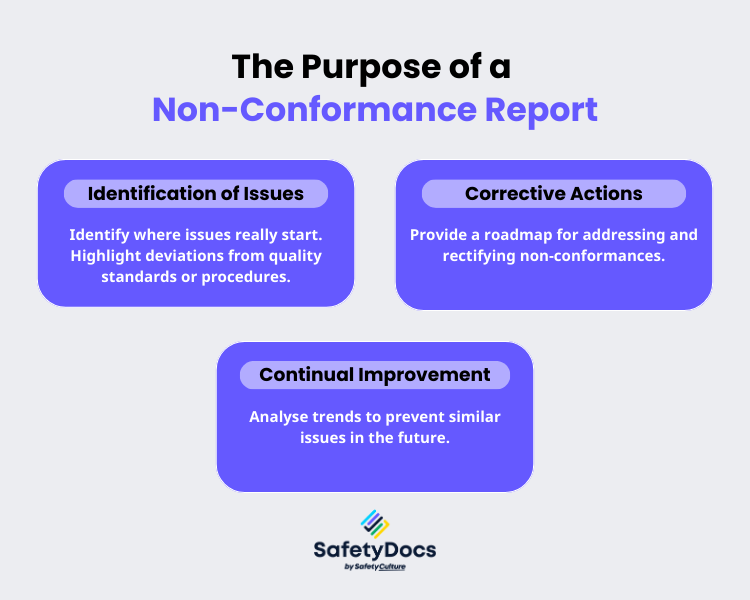Non-Conformance Reports (NCRs) are powerful tools for identifying deviations from established standards and implementing corrective actions that drive continual improvement. When used effectively, NCRs can help prevent recurring issues, enhance quality, and ensure compliance with industry regulations.
In this guide, we will walk you through the process of creating an effective NCR, focusing on accurate documentation, root cause analysis, and actionable strategies to prevent recurring issues.
What is a Non-Conformance Report?
A Non-Conformance Report (NCR) is a formal document that records instances where your product, service, or process does not meet established quality standards, regulations, or specifications. NCRs play a vital role in quality management by:
- Identifying quality issues early
- Ensuring corrective actions are implemented
- Preventing recurrence through Root Cause Analysis (RCA)
- Keeping you compliant with industry standards such as ISO 9001
The Purpose of NCRs:
- Identification of Issues – Identify where issues really start. Highlight deviations from quality standards or procedures.
- Corrective Actions – Provide a roadmap for addressing and rectifying non-conformances.
- Continual Improvement – Analyse trends to prevent similar issues in the future.
Examples of non-conformances include defective products, missed deadlines, or non-compliance with safety protocols. By documenting and addressing these issues systematically, you build a culture of continual improvement.

Key Elements of an NCR
A well-structured NCR should contain the following essential components to ensure a thorough investigation and resolution of quality issues:
1. Description of Non-Conformance
A clear and detailed description of the non-conformance is the foundation of an effective NCR. This is where you should outline:
- The nature of the issue (e.g., defective product, process deviation, safety violation).
- When and where the issue occurred (date, time, location).
- The individuals or teams involved or affected.
- Any immediate impact on operations, safety, or compliance.
Providing a comprehensive description ensures that all stakeholders understand the problem and can take appropriate corrective action.
2. Supporting Evidence
You need to validate the non-conformance and facilitate an accurate analysis, with supporting evidence playing a crucial role. This may include:
- Photographs or videos of the issue.
- Inspection reports highlighting deviations from quality standards.
- Test results that confirm the failure of a product or process.
- Copies of documentation, such as work orders, logs, or compliance reports.
Well-documented evidence strengthens the credibility of the NCR and aids in root cause analysis.
3. Root Cause Analysis (RCA)
Identifying the real cause of the non-conformance is essential to preventing recurrence. You can use structured problem-solving techniques, such as:
- 5 Whys Analysis: Asking "why" repeatedly to trace the issue back to its root cause.
- Fishbone Diagram (Ishikawa Method): Categorising potential causes into areas such as materials, methods, people, environment, and equipment.
- Failure Mode and Effects Analysis (FMEA): Assessing the severity, likelihood, and detection of failures in a process.
By focusing on the true root cause rather than symptoms, organisations can implement more effective corrective measures.
4. Corrective Action Plan
This is where you outline the steps to resolve the non-conformance and should include:
- The specific corrective actions to be taken (e.g., process adjustments, product modifications, retraining of personnel).
- Who is responsible for implementing the corrective actions.
- The timeline for completion.
A well-defined corrective action plan ensures accountability and swift resolution of the issue.
5. Preventive Measures
Beyond fixing the immediate problem, you need to take steps to prevent similar non-conformances from happening in the future. This may involve:
- Updating Standard Operating Procedures (SOPs) to reflect best practices.
- Providing additional training to employees to reinforce quality standards.
- Implementing new quality control measures such as enhanced inspections or automated monitoring systems.
Proactive measures help mitigate future risks and improve overall process reliability.
6. Follow-Up Evaluation
Even after corrective actions are implemented, you need to follow up to verify their effectiveness. This section should document:
- The results of subsequent audits or inspections to confirm that the issue has been resolved.
- Feedback from employees or customers regarding the implemented solutions.
- Any adjustments needed if the initial corrective actions were insufficient.
Regular follow-ups ensure that the corrective measures are sustainable and that the organisation continues to improve its processes.

Using NCRs to Drive Continual Improvement
Beyond addressing individual incidents, NCRs offer valuable insights into systemic quality issues. Organisations can use NCR data to:
- Identify patterns and trends in non-conformances
- Improve training and competency programs
- Enhance quality control processes
- Strengthen compliance with industry standards
A proactive approach to NCR management ensures that organisations do not merely react to quality issues but actively use data to refine their operations. For example, analysing recurring non-conformances can reveal weak points in a supply chain, outdated training programs, or ineffective quality controls.
NCRs can be used to engage employees in a culture of quality. Regularly reviewing NCR trends in team meetings can help foster collective responsibility for quality improvement. By integrating NCR findings into a broader quality management strategy, companies can foster a culture of continual improvement and operational excellence, ultimately enhancing productivity, reducing waste, and improving customer satisfaction.
Common Pitfalls and How to Avoid Them
While NCRs are invaluable for quality management, there are certain pitfalls that can hinder their effectiveness. But by being aware of these pitfalls and taking steps to avoid them you can use NCRs to drive real quality improvement in your organisation.
1. Incomplete Documentation
One of the most common issues with NCRs is insufficient documentation. When there’s missing information or when details are vague, it becomes challenging to identify the root cause and implement effective corrective actions. Without a comprehensive record of what really happened, when it happened, and why, quality teams may struggle to prevent the issue from recurring.
Pitfall: Lack of detailed information makes it difficult to analyse the issue.
Solution: Use structured NCR templates like an Incident Investigation Report Form and ensure all relevant details are captured comprehensively. Provide training to employees on how to consistently document issues clearly.
2. Failure to Conduct Root Cause Analysis
Merely identifying a non-conformance is not enough; failing to analyse the root cause often leads to repeated issues. Many organisations rush to implement corrective actions without truly understanding why the problem occurred in the first place.
Pitfall: Addressing symptoms rather than the underlying problem leads to recurring issues.
Solution: Implement systematic analysis methods like the 5 Whys with the use of effective templates like an Incident Report Form to really get to the bottom of issues. Encourage a problem-solving mindset within the team and provide training on effective RCA techniques.
3. Lack of Follow-Up and Verification
Even when corrective actions are assigned, they may not be effectively implemented or monitored. Without proper follow-up, organisations risk incomplete resolutions, allowing non-conformances to resurface.
Pitfall: Corrective actions are assigned but not tracked, leading to unresolved issues.
Solution: Schedule regular evaluations to track the progress and monitor effectiveness of actions made to fix issues. Use automated tracking systems or quality management tools to ensure accountability. Review past Non-Conformance Reports to see patterns and gaps in quality and safety.
4. Overcomplication of NCRs
Sometimes, NCRs become overly complex, making them difficult to complete and act upon. Including too many issues in one report can dilute focus and reduce the effectiveness of corrective measures.
Pitfall: Addressing too many concerns in one report can dilute focus.
Solution: To simplify the reporting process, limit each NCR to a single issue. Use clear, concise, and easy-to-understand terminology and structured formats.
5. Resistance to Change
Implementing corrective actions often requires changes to processes, training, or responsibilities. When employees and stakeholders resist adopting those new processes, corrective actions can fall short.
Pitfall: Employees may resist adopting new processes, leading to ineffective corrective actions.
Solution: Consider how your organisation implements change management and communicate the importance of NCRs in improving quality and efficiency. Involve employees in the process, provide adequate training, and highlight the benefits of change to encourage employee buy-in and engagement.

6. Ineffective Corrective Actions
Not all corrective actions lead to meaningful improvements. Sometimes, organisations implement temporary fixes instead of addressing the root cause of the problem, which then leads to recurring issues.
Pitfall: Quick fixes that do not address the underlying problem result in repeated non-conformances.
Solution: Ensure corrective and preventive actions are specific, measurable, and address the root cause. Reviewing past corrective action reports can help you identify patterns and make sure long-term solutions are implemented.
NCRs Drive Lasting Quality Improvements
Non-Conformance Reports play a vital role in fostering quality improvements by documenting issues, analysing root causes, and implementing effective corrective measures. By following best practices outlined in this guide, you can help your organisation transform non-conformances into opportunities for growth.
Key Takeaways:
- Accurate documentation is crucial for effective problem-solving.
- Root cause analysis helps identify underlying issues.
- Corrective actions must be actionable and monitored over time.
- NCRs should be integrated into a broader quality management strategy.
Enhance Your NCR Process with SafetyDocs
Is your non-conformance report process driving real improvements in your quality management? SafetyDocs by SafetyCulture provides the tools you need to streamline your NCR process, improve compliance, and foster a culture of continual improvement. Our ready-to-use templates make it easy to document, analyse, and resolve non-conformances with confidence.
Explore Our Quality Management Resources:
Start optimising your quality assurance processes with SafetyDocs. Contact us today to refine your NCR process and achieve meaningful improvements in quality management.
Our team of experts is dedicated to providing accurate and informative content. Craig Cruickshank, our senior HSEQ advisor at SafetyDocs by SafetyCulture has reviewed this blog post to ensure the highest level of quality.
Learn more about Craig's work on LinkedIn for more industry insights.
Available for instant download and supplied in fully editable MS Word format for use in your business.
Please note that the above information is provided as a comment only and should not be relied on as professional, legal or financial advice.
Share This Article
